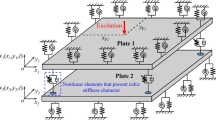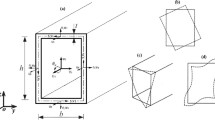Abstract
The structural analysis of thin composite structures requires robust and effective shell elements. In this paper the variational formulation is based on a Hu–Washizu functional with independent displacements, stress resultants and shell strains. For the independent shell strains an additional interpolation part is introduced. This yields an improved convergence behaviour especially for laminated shells with coupled membrane and bending stiffness. The developed mixed hybrid shell element possesses the correct rank and fulfills the in–plane and bending patch test. The formulation is tested by several nonlinear examples including bifurcation and post–buckling response. The essential feature of the new element is the robustness in nonlinear computations with large rigid body motions. It allows very large load steps in comparison to standard displacement models.
Similar content being viewed by others
References
Dorninger K, Rammerstorfer FG (1990) A Layered Composite Shell Element for Elastic and Thermoelastic Stress and Stability Analysis at Large Deformations. Int Numer Meth Eng 30:833–858
Koiter WT (1966) On the nonlinear theory of thin elastic shells. Proc Kon Ned Ak Wet B69:1–54
Ahmad S, Irons BM, Zienkiewicz OC (1970) Analysis of thick and thin shell structures by curved finite elements. Int J Numer Meth Eng 2:419–451
Stanley GM, Park KC, Hughes TJR (1986) Continuum–Based Resultant Shell Elements. In: Hughes TJR, Hinton E (eds) Finite Element Methods for Plate and Shell Structures 1: Element Technology. Pineridge Press Swansea UK
Zienkiewicz OC, Taylor RL, Too J (1971) Reduced integration techniques in general analysis of plates and shells. Int J Numer Meth Eng 3:275–290
Belytschko T, Tsay C-S (1983) A stabilization procedure for the quadrilateral plate element with one–point quadrature. Int J Numer Meth Eng 19:405–419
Liu WK, Law SE, Lam D, Belytschko T (1986) Resultant–stress degenerated shell element. Comp Meth Appl Mech Eng 55:261–300
Belytschko T, Leviathan I (1994) Physical stabilization of the 4–node shell element with one point quadrature. Comp Meth Appl Mech Eng 113:321–350
Simo JC, Rifai MS (1990) A class of mixed assumed strain methods and the method of incompatible modes. Int J Numer Meth Eng 29:1595–1638
Betsch P, Gruttmann F, Stein E (1996) A 4-node finite shell element for the implementation of general hyperelastic 3d–elasticity at finite strains. Comp Meth Appl Mech Eng 130:57–79
MacNeal RH (1978) A simple quadrilateral shell element. Comput & Struct 8:175–183
Hughes TJR, Tezduyar TE (1981) Finite elements based upon Mindlin plate theory, with particular reference to the 4-node bilinear isoparametric element. J Appl Mech 48:587–595
Dvorkin E, Bathe K.J (1984) A continuum mechanics based four node shell element for general nonlinear analysis. Eng Computat 1:77–88
Bathe K-J, Dvorkin E (1985) A 4-Node Plate bending element based on Mindlin/Reissner theory and a mixed interpolation. Int J Numer Meth Eng 21:367–383
Gruttmann F, Wagner W, Wriggers P (1992) A Nonlinear Quadrilateral Shell Element with Drilling Degrees of Freedom. Arch Appl Mech 62:474–486
Wagner W, Gruttmann, F (2005) A robust nonlinear mixed hybrid quadrilateral shell element. Int J Numer Meth Eng 64:635–666
Hughes TJR (1987) The Finite Element Method, Linear static and Dynamic Finite Element Analysis, Prentice–Hall, Inc., Englewood Cliffs, New Jersey
Gruttmann F, Wagner W (2004) A stabilized one–point integrated quadrilateral Reissner–Mindlin plate element. Int J Numer Meth Eng 61:2273–2295
Simo JC, Fox DD, Rifai MS (1989) On a stress resultant geometrically exact shell model. Part II: The linear theory; Computational aspects. Comp Meth Appl Mech Eng 73:53–92
Pian THH, Sumihara K (1984) Rational approach for assumed stress finite elements. Int J Numer Meth Eng 20:1685–1695
Piltner R, Taylor RL (1999) A systematic construction of B-bar functions for linear and non-linear mixed–enhanced finite elements for plane elasticity problems. Int J Numer Meth Eng. 44:615–639
Kasper EP, Taylor RL (2000) A mixed-enhanced strain method part i: Geometrically linear problems. Comput & Struct 75:237–250
Kasper EP, Taylor RL (2000) A mixed-enhanced strain method part ii: Geometrically nonlinear problems. Comput & Struct 75: 251–260
Gruttmann F, Wagner W (2005) A linear quadrilateral shell element with fast stiffness computation. Comp Meth Appl Mech Eng 194:4279–4300
Hughes TJR, Liu WK (1981) Nonlinear finite element analysis of shells: Part I. Three dimensional shells. Comp Meth Appl Mech Eng 26:331–362
Simo JC (1993) On a stress resultant geometrically exact shell model. Part VII: Shell intersections with 5/6-DOF finite element formulations. Comp Meth Appl Mech Eng 108:319–339
Zienkiewicz OC, Taylor RL (2000) The Finite Element Method, Vol. 1–3, 5. edition, Butterworth-Heinemann, Oxford
MacNeal RH, Harder RL (1985) A proposed standard set of problems to test finite element accuracy. Finite Elements in Analysis and Design 1:3–20
Basar Y, Montag U, Ding Y (1993) On an isoparametric finite–element for composite laminates with finite rotations. Computat Mech 12:329–348
Wagner W, Gruttmann F (1994) A simple finite rotation formulation for composite shell elements. Eng Computat 11:145–176
Gruttmann F, Sauer R, Wagner W (2000) Theory and Numerics of Three–Dimensional Beams with Elastoplastic Material Behaviour. Int J Numer Meth Eng 48:1675–1702
Tsai WS (1988) Composites Design, Think Composites, Dayton
Cook RD, Malkus DS, Plesha ME (1989) Concepts and Applications of Finite Element Analysis, John Wiley & Sons, New York
Abramovich H, Grunwald A, Pevsner P, Weller T, David A, Ghilai G, Green A, Pekker N (2003) Experiments on Axial Compression Postbuckling Behavior of Stiffened Cylindrical Composite Panels, Proceeding of 44th AIAA/ASME/ASCE/AHS Structures, Structural Dynamics and Material Conference, Norfolk, VI, USA, AIAA paper No. 2003–1793
Abramovich H, Grunwald A, Weller T (2003) Improved Postbuckling Simulation for Design of Fibre Composite Stiffened Fuselage Structures- POSICOSS- Part 1 - Test results, TAE Report No. 990, January 2003
Wagner W, Wriggers P (1988) A Simple Method for the Calculation of Postcritical Branches. Eng Computa 5:103–109
Hilber HM, Hughes TJR, Taylor RL (1977) Improved numerical dissipation for time integration algorithms in structural dynamics. Earthquake Eng Struct dyn 5:283–292
Author information
Authors and Affiliations
Corresponding author
Rights and permissions
About this article
Cite this article
Gruttmann, F., Wagner, W. Structural analysis of composite laminates using a mixed hybrid shell element. Comput Mech 37, 479–497 (2006). https://doi.org/10.1007/s00466-005-0730-1
Received:
Accepted:
Published:
Issue Date:
DOI: https://doi.org/10.1007/s00466-005-0730-1




